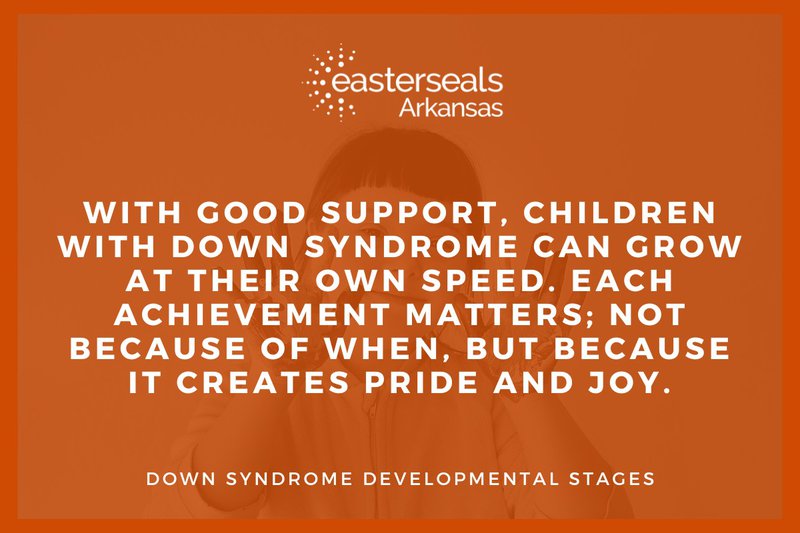
If you're raising or teaching a child with Down syndrome, you've likely wondered when they will begin to walk, talk, or play like other children their age. Understanding the Down syndrome developmental stages helps families and educators provide the right support at each stage. While milestones may take longer to reach, progress happens with consistent care, encouragement, and the proper tools.
Key Takeaways:
- Children with Down syndrome reach milestones later, but in the same order as other children.
- Delays are due to low muscle tone, loose joints, and reduced strength (up to 50% less).
- Speech delays are common; early speech therapy and visual tools support communication.
- Developmental delays may appear as early as 2 to 3 months.
- Early support improves motor, thinking, and speech development.
- Therapy (physical, occupational, and speech) offers the most help when started before age 1.
- Developmental age often differs from actual age; therapy should match ability levels.
- Social skills are often on time; playing with peers supports learning and emotional growth.
Timeline of the Down Syndrome Developmental Stages
Recognizing and supporting each stage of development creates a foundation for steady progress and lifelong skills.
Motor Down Syndrome Developmental Stages
Children with Down syndrome take more time to reach motor milestones than other children.
Most babies sit alone around six months. Children with Down syndrome may not sit alone until closer to 36 months. Similarly, walking often begins around 12 months in other children, but may take closer to 48 months here.
This delay is caused by:
- Low muscle tone
- Joint flexibility
- Weak balance
These traits make control and quick movement more difficult.
Fine motor skills, such as holding a spoon or crayon, also take longer to develop. Children with Down syndrome often begin using a spoon by 13 to 39 months, compared with 12 to 20 months for their peers. These skills form the foundation of movement within the Down syndrome developmental stages. These delays don’t mean a child can’t learn. They just need more time and support to build control.
Down Syndrome Developmental Stages: Language and Self-Help
Children with Down syndrome usually say their first word between 12 and 48 months. By that time, most children without Down syndrome are saying short phrases. Two-word phrases may not appear until 24 to 90 months. This is one of the biggest areas of delay and often requires speech therapy.
Some other major skills to pay attention to are:
- Finger feeding: around 10 to 24 months
- Using a spoon: between 13 to 39 months
- Cup use: up to 32 months
- Dressing independently: up to 102 months (about 8½ years)
Social Skills and Connection
Social skills such as smiling and bonding with people may develop closer to typical ages. Babies with Down syndrome often smile in response between 1 and 5 months, compared to 1 to 3 months for others. Many enjoy social interactions and are highly responsive, which helps support how they learn with others. Social engagement plays a significant role in the Down syndrome developmental stages, helping children connect and learn through play.
Comparing Developmental Milestones
Children with Down syndrome typically reach milestones in the same order as neurotypical children, but they happen months or even years later.
| Developmental Milestone | Down Syndrome Timeline | Neurotypical Timeline |
|---|---|---|
| Sitting | 6 to 36 months | 5 to 6 months |
| Crawling | 8 to 22 months | 6 to 12 months |
| Walking | 12 to 48 months | 9 to 18 months |
| First word | 12 to 48 months | 12 to 24 months |
| Two word phrases | 24 to 90 months | 15 to 32 months |
Each child is different. Some learn faster than others. This is why many professionals use tools made for children with Down syndrome instead of general charts. These tools help set goals that match real life.
Early support has a big effect. Schools like The Academy at Easterseals Arkansas support students throughout the developmental stages, matching the pace individually to the student. Skills in speech, movement, and basic care grow more easily with early help. With good support, children with Down syndrome can grow at their own speed. Each achievement matters, not because of when, but because it creates pride and joy.
Delays in Cognitive and Physical Development Milestones
Children with Down syndrome often have low muscle tone, called hypotonia. Their muscles feel soft and lack strength. Low tone makes it hard to lift the head, sit, crawl, and walk.
Babies with Down syndrome may sit up between 6 and 36 months, while most sit by 6 months. The delay isn’t due to a lack of learning ability. Their bodies just need more help to support controlled movement. Low tone limits how muscles hold joints and guide bones. That’s what makes motor tasks more difficult and slower to pick up.
Children with Down syndrome often experience delays in balance, too. Weaker muscles and looser joints are common. Children with Down syndrome may have 40 to 50% less muscle strength than others. Flexible joints can also make it harder to stay steady.
These differences mean children may fall more, tire easily, and need help climbing stairs or standing. Stronger leg muscles are key to running and jumping. These usually develop later. Motor work with trained support helps children gain these skills.
Neurological Differences in Down Syndrome Developmental Stages
The brain grows differently in children with Down syndrome. Two key brain areas, the cerebellum and hippocampus, are usually smaller. These regions support memory and learning, so growth is slower.
Learning new words or solving puzzles can feel harder. Memory also affects activities like reading or math. Children may need support step by step. Hands-on games, pictures, and music often work best for learning.
Health conditions can make things worse. Sleep apnea, which limits sleep quality, is common. Poor sleep slows learning. Hearing loss limits language practice.
Starting therapy in infancy has been shown to help. Research explains how strength, balance, and brain development all connect. Helping children move means helping them think, too. Supporting early brain and motor development is one of the most effective ways to encourage progress throughout the Down syndrome developmental stages.
Though delays happen, children have real learning strength. With time and support, they keep progressing.

Tracking and Assessing Developmental Progress
Tracking growth begins with clear tools and steady review. Consistent tracking ensures children progress through the Down syndrome developmental stages at their own pace. Doctors and families often use milestone lists created for Down syndrome. These tools review movement, language, learning, and social skills.
Tracking should reflect how children with Down syndrome grow. Doctors often use the Down Syndrome Developmental Scale or the Ages & Stages Questionnaire. These show what to expect and when. Such checklists set clearer goals that match the child, not a general timeline.
Families can also use free milestone tracker PDFs from trusted clinics and groups. These show goals for movement and thinking, often with ideas for home practice.
Healthcare Providers and Milestone Progression
Progress is reviewed using tests that check each simple skill. These can be small, like picking up a toy or pointing to an object. Doctors look at how a child walks, communicates, and eats. Each part may have a different target based on common patterns within Down syndrome.
If a step is missed, the delay is tracked over time. The point is progress, not speed. Many providers include teachers or therapists to guide development.
Parents and Milestone Progression
Parents notice small changes daily. They use toddler milestone checklists to write down what they see. These help show what’s going well and what needs help based on the suggested Down syndrome developmental stages. For example, they may track eye contact or spoon use.
Parents support growth through play, talking, books, and simple daily tasks. If something doesn’t seem right, they can speak up and request support.
This tracking matters because early intervention improves school readiness and speech.
Families grow along with the child, one skill at a time.
Early Signs of Developmental Delays
Delays in children with Down syndrome may show as early as 2 to 3 months. Some early signs include:
- Weak or slow head control by 2 to 3 months
- Limited movement or limb activity
- Delayed smiling, rolling, or sitting
- Loose muscle tone and slow reaction times
- Little interest in toys or people
- Missing babbling sounds by 6 months
- Delayed or limited eye movement
Babies may smile, roll, sit up, or make sounds later than expected. They may not move their limbs as much or grip objects tightly. Toys or people may not hold their interest. These are signs to watch.
Speech delays begin early. By 6 months, most babies start babbling sounds. A baby with Down syndrome may not. Eye movement may also be behind. These signs show areas that may benefit from early support.
When to Consider Scheduling a Developmental Screening
Caregivers should act and pursue developmental screening if key steps like head control, eye contact, smiling, or making sounds aren’t in place by 6 months.
Screenings check eyesight, hearing, motion, and overall growth. Early checks guide which therapies are helpful. They can be done even before the baby starts walking. Later on, preschool groups can offer added help.
Early signs may seem small at first. Acting on them early supports the best possible growth.
Fine motor skills are another marker. By two years old, if a child doesn’t walk or speak, more help may be needed.
Large gaps from average target dates are signals, not failures. Early support is worth the effort.
Understand and Empower with Easterseals Arkansas
Every milestone matters. At Easterseals Arkansas, we help children with Down syndrome build strength, confidence, and independence through every step of the Down syndrome developmental stages. Resources like early intervention, therapy, and family-centered support make a meaningful difference in your and your child’s lives. With expert guidance and compassionate care, progress becomes possible at every stage of development.
Take the next step toward empowering your child’s growth: explore Easterseals Arkansas programs and discover how early support creates lifelong potential.
